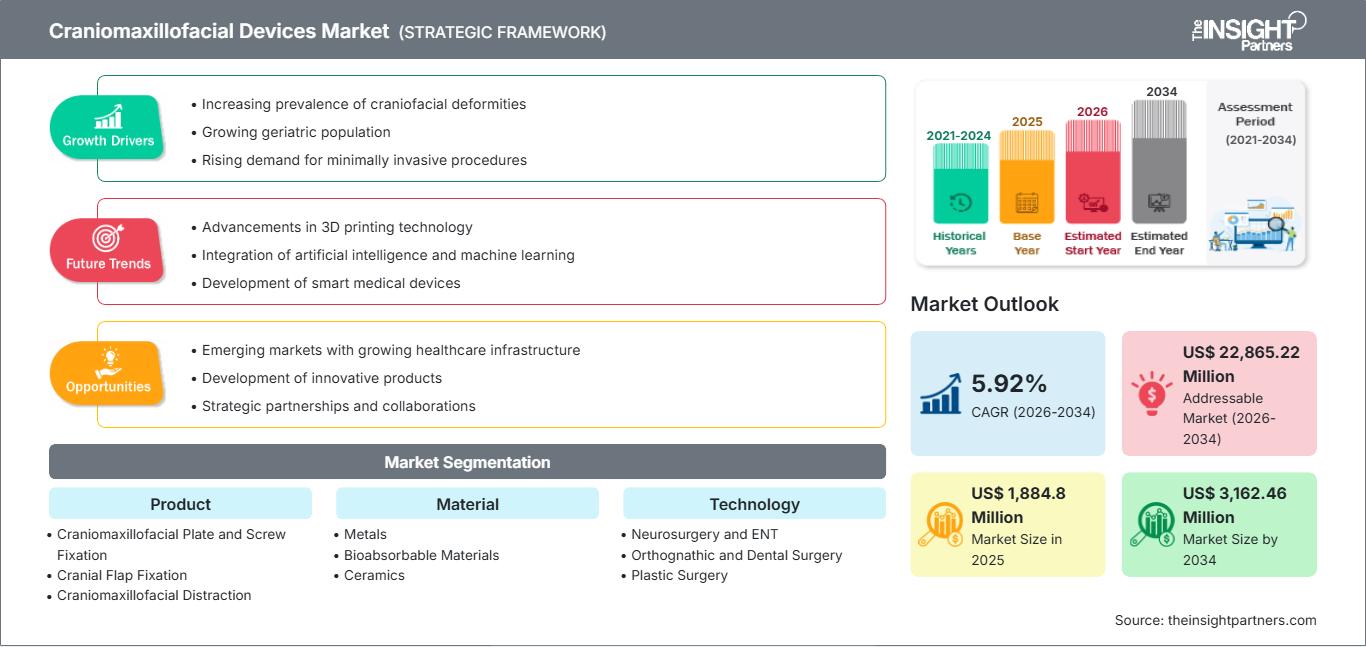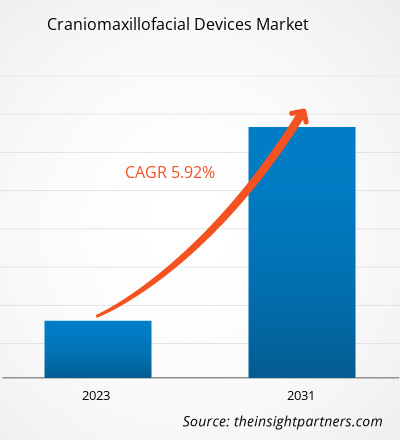Il mercato dei dispositivi craniomaxillofacciali, valutato a 1.884,8 milioni di dollari nel 2025, dovrebbe raggiungere i 3.162,46 milioni di dollari entro il 2034, con un CAGR del 5,92% nel periodo 2026-2034. Le condizioni di mercato continuano a evolversi, aprendo nuove opportunità per gli stakeholder. Il panorama generale riflette un progresso stabile e un potenziale di crescita a lungo termine.
I fattori chiave che guidano la crescita del mercato dei dispositivi craniomaxillofacciali includono la crescente domanda di procedure mini-invasive, gli sviluppi nelle tecnologie di stampa 3D e di imaging e l'aumento mondiale del numero di lesioni gravi e casi di fratture facciali. I progressi nelle tecnologie di stampa 3D e di imaging consentono ai produttori di offrire soluzioni personalizzate ai clienti. Oltre ai progressi tecnologici e alle soluzioni personalizzate, i migliori risultati per i pazienti alimentano il mercato dei dispositivi craniomaxillofacciali. Le tendenze del mercato dei dispositivi craniomaxillofacciali includono impianti realizzati con materiali bioriassorbibili per ridurre al minimo i problemi a lungo termine.
Fattori di crescita e sfide:
Si prevede che la necessità di procedure chirurgiche ricostruttive efficienti e l'aumento del numero di incidenti stradali causati dall'urbanizzazione e dall'industrializzazione alimenteranno il mercato dei dispositivi craniomaxillo-facciali. Ad esempio, diverse cause di fratture mandibolari includono aggressioni, infortuni sportivi e incidenti stradali, come affermato nell'articolo "Prevalenza e pattern delle fratture mandibolari: uno studio retrospettivo in India", pubblicato nel 2022. Le tecniche mini-invasive hanno rivoluzionato il campo della chirurgia craniomaxillo-facciale, offrendo ai pazienti vantaggi come cicatrici ridotte, tempi di recupero più brevi e un minor rischio di complicanze rispetto alla tradizionale chirurgia a cielo aperto. La crescente adozione di procedure mini-invasive innesca la domanda di dispositivi specializzati progettati per questi approcci. Dispositivi craniomaxillo-facciali come distrattori, placche, viti e impianti vengono innovati per soddisfare i requisiti specifici della chirurgia mini-invasiva, consentendo ai chirurghi di eseguire procedure complesse con precisione ed efficienza. Inoltre, i progressi nella tecnologia di stampa 3D hanno reso disponibile un gran numero di impianti efficaci e personalizzati, caratterizzati da elevata precisione. Poiché sempre più operatori sanitari riconoscono i vantaggi delle procedure mini-invasive in termini di miglioramento dei risultati e della soddisfazione dei pazienti, si prevede che la domanda di dispositivi craniomaxillofacciali innovativi, progettati appositamente per queste tecniche, continuerà ad aumentare nei prossimi anni.
La limitata disponibilità di professionisti qualificati con competenze in tecniche chirurgiche avanzate ostacola la crescita e lo sviluppo del mercato, poiché gli operatori sanitari faticano a soddisfare la crescente domanda di procedure complesse. Colmare questo divario tra domanda e offerta attraverso programmi di formazione e iniziative educative sarà probabilmente cruciale per liberare appieno il potenziale del mercato dei dispositivi craniomaxillofacciali e migliorare i risultati per i pazienti.
Personalizza questo report in base alle tue esigenze
Riceverai la personalizzazione gratuita di qualsiasi report, incluse parti di questo report, analisi a livello nazionale, pacchetto dati Excel e potrai usufruire di fantastiche offerte e sconti per start-up e università.
Mercato dei dispositivi craniomaxillofacciali: approfondimenti strategici

-
Scopri le principali tendenze di mercato di questo rapporto.Questo campione GRATUITO includerà analisi dei dati, che spaziano dalle tendenze di mercato alle stime e alle previsioni.
Segmentazione e ambito del report:
L'analisi del mercato dei dispositivi craniomaxillofacciali è stata condotta considerando i seguenti segmenti: prodotto, materiale e applicazione. In base all'area geografica, il mercato è segmentato in Nord America (Stati Uniti, Canada e Messico), Europa (Regno Unito, Germania, Francia, Italia, Spagna e resto d'Europa), Asia-Pacifico (Cina, Giappone, India, Australia, Corea del Sud e resto dell'Asia-Pacifico), Medio Oriente e Africa (Emirati Arabi Uniti, Arabia Saudita, Sudafrica e resto del Medio Oriente e dell'Africa) e Sud e Centro America (Brasile, Argentina e resto del Sud e Centro America).
Analisi segmentale:
Approfondimenti basati sui prodotti
In base al prodotto, il mercato è segmentato in fissazione craniomaxillofacciale con placche e viti, fissazione con lembo cranico, distrazione craniomaxillofacciale, sostituzione dell'articolazione temporo-mandibolare, fissazione toracica e sostituzione dell'innesto osseo. Il segmento delle fissazioni craniomaxillofacciali con placche e viti ha detenuto la quota di mercato più ampia nel 2023. Si prevede che registrerà il CAGR più elevato dal 2023 al 2031.
Approfondimenti basati sui materiali
In base al materiale, il mercato dei dispositivi craniomaxillofacciali è segmentato in metalli, materiali bioassorbibili e ceramiche. Si prevede che il segmento dei metalli detenga una quota significativa entro il 2031.
Approfondimenti basati sulle applicazioni
In base all'applicazione, il mercato è suddiviso in neurochirurgia e otorinolaringoiatria, chirurgia ortognatica e odontoiatrica e chirurgia plastica. Si prevede che il segmento della chirurgia ortognatica e odontoiatrica detenga una quota significativa entro il 2031.
Dispositivi craniomaxillofacciali
Approfondimenti regionali sul mercato dei dispositivi craniomaxillo-facciali
Le tendenze regionali e i fattori che influenzano il mercato dei dispositivi craniomaxillo-facciali durante il periodo di previsione sono stati ampiamente spiegati dagli analisti di The Insight Partners. Questa sezione illustra anche i segmenti e la geografia del mercato dei dispositivi craniomaxillo-facciali in Nord America, Europa, Asia-Pacifico, Medio Oriente e Africa, America Meridionale e Centrale.
Ambito del rapporto di mercato sui dispositivi craniomaxillofacciali
| Attributo del report | Dettagli |
|---|---|
| Dimensioni del mercato nel 2025 | 1.884,8 milioni di dollari USA |
| Dimensioni del mercato entro il 2034 | 3.162,46 milioni di dollari USA |
| CAGR globale (2026 - 2034) | 5,92% |
| Dati storici | 2021-2024 |
| Periodo di previsione | 2026-2034 |
| Segmenti coperti |
Per prodotto
|
| Regioni e paesi coperti |
America del Nord
|
| Leader di mercato e profili aziendali chiave |
|
Densità degli operatori del mercato dei dispositivi craniomaxillofacciali: comprendere il suo impatto sulle dinamiche aziendali
Il mercato dei dispositivi craniomaxillofacciali è in rapida crescita, trainato dalla crescente domanda degli utenti finali, dovuta a fattori quali l'evoluzione delle preferenze dei consumatori, i progressi tecnologici e una maggiore consapevolezza dei benefici del prodotto. Con l'aumento della domanda, le aziende stanno ampliando la propria offerta, innovando per soddisfare le esigenze dei consumatori e sfruttando le tendenze emergenti, alimentando ulteriormente la crescita del mercato.

- Ottieni una panoramica dei principali attori del mercato dei dispositivi craniomaxillofacciali
Analisi regionale:
L'ambito geografico del rapporto sul mercato dei dispositivi craniomaxillo-facciali comprende Nord America, Europa, Asia-Pacifico, Medio Oriente e Africa, Sud e Centro America. Il Nord America deteneva la quota di mercato maggiore nel 2023 e si prevede che manterrà la sua posizione dominante (in termini di quota) durante il periodo di previsione. Gli Stati Uniti detengono la quota maggiore del mercato nordamericano e globale. La crescita del mercato in questo Paese è attribuita all'elevata partecipazione alle attività sportive, all'aumento del numero di casi di frattura facciale e al gran numero di atleti internazionali residenti nel Paese. Inoltre, la crescente domanda di procedure mini-invasive probabilmente favorirà il mercato in questo Paese.
Grazie al loro sistema sanitario altamente sviluppato, gli Stati Uniti hanno attirato l'attenzione delle grandi aziende globali che cercano di aumentare la propria quota di mercato. Inoltre, il numero di interventi chirurgici eseguiti negli Stati Uniti aumenta di anno in anno, a vantaggio del mercato in esame. L'American Academy of Craniomaxillofacial Surgeons discute gli ultimi sviluppi e le specificità della ricerca in chirurgia craniomaxillofacciale. Il futuro della neurochirurgia fetale in utero e di altre metodiche chirurgiche è stato esaminato durante il meeting annuale del 2021.
Panorama competitivo e aziende chiave:
Le previsioni di mercato dei dispositivi craniomaxillo-facciali presentate in questo rapporto possono aiutare gli stakeholder di questo mercato a pianificare le proprie strategie di crescita. DePuy Synthes (J&J), Stryker, Medtronic, B. Braun Melsungen AG, Reni Shaw plc., Medartis AG, KLS Martin Group, Xilloc Medical B. V, Synimed e Zimmer-Biomet sono alcune delle aziende chiave descritte nel rapporto di mercato dei dispositivi craniomaxillo-facciali. Queste aziende si concentrano sull'ampliamento della propria offerta per soddisfare la crescente domanda dei consumatori in tutto il mondo. La loro presenza globale consente loro di servire numerosi clienti, consentendo loro di espandere la propria presenza sul mercato.
- Analisi storica (2 anni), anno base, previsione (7 anni) con CAGR
- Analisi PEST e SWOT
- Valore/volume delle dimensioni del mercato - Globale, Regionale, Nazionale
- Industria e panorama competitivo
- Set di dati Excel
Report recenti
Rapporti correlati
Testimonianze
Motivo dell'acquisto
- Processo decisionale informato
- Comprensione delle dinamiche di mercato
- Analisi competitiva
- Analisi dei clienti
- Previsioni di mercato
- Mitigazione del rischio
- Pianificazione strategica
- Giustificazione degli investimenti
- Identificazione dei mercati emergenti
- Miglioramento delle strategie di marketing
- Aumento dell'efficienza operativa
- Allineamento alle tendenze normative






















 Ottieni un campione gratuito per - Mercato dei dispositivi craniomaxillofacciali
Ottieni un campione gratuito per - Mercato dei dispositivi craniomaxillofacciali